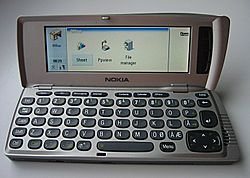
The Nokia Communicator is a brand name for a series of business-optimized mobile phones marketed by Nokia Corporation, all of which appear as normal (if large) phones on the outside, and open in clamshell format to access a QWERTY keyboard and an LCD screen nearly the size of the device footprint.
Contents
Nokia Communicators have Internet connectivity and clients for Internet and non-Internet communication services. The earlier 9000 series Communicators introduced features which later developed into smartphones. The latest Communicator model, the Nokia E90 Communicator, is part of the Nokia Eseries.





